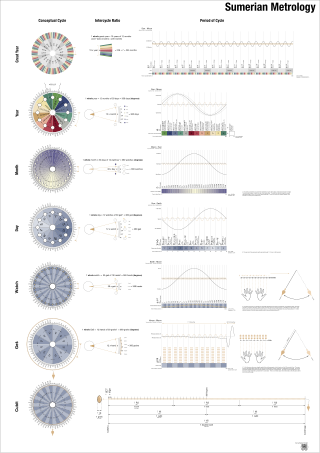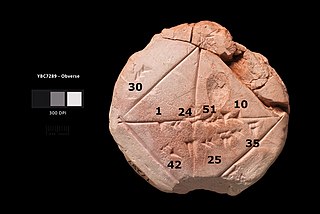Related Research Articles

Mesopotamia is a historical region of West Asia situated within the Tigris–Euphrates river system, in the northern part of the Fertile Crescent. Today, Mesopotamia is known as present-day Iraq. In the broader sense, the historical region of Mesopotamia included parts of present-day Iran, Kuwait, Syria, and Turkey.

Akkadian is an extinct East Semitic language that was spoken in ancient Mesopotamia from the third millennium BC until its gradual replacement in common use by Old Aramaic among Assyrians and Babylonians from the 8th century BC.
Sippar was an ancient Near Eastern Sumerian and later Babylonian city on the east bank of the Euphrates river. Its tell is located at the site of modern Tell Abu Habbah near Yusufiyah in Iraq's Baghdad Governorate, some 69 km (43 mi) north of Babylon and 30 km (19 mi) southwest of Baghdad. The city's ancient name, Sippar, could also refer to its sister city, Sippar-Amnanum ; a more specific designation for the city here referred to as Sippar was Sippar-Yahrurum.

Babylonian cuneiform numerals, also used in Assyria and Chaldea, were written in cuneiform, using a wedge-tipped reed stylus to print a mark on a soft clay tablet which would be exposed in the sun to harden to create a permanent record.

Bedřich Hrozný, also known as Friedrich Hrozny, was a Czech orientalist and linguist. He contributed to the decipherment of the ancient Hittite language, identified it as an Indo-European language, and laid the groundwork for the development of Hittitology.

Cuneiform is a logo-syllabic writing system that was used to write several languages of the Ancient Near East. The script was in active use from the early Bronze Age until the beginning of the Common Era. Cuneiform scripts are marked by and named for the characteristic wedge-shaped impressions which form their signs. Cuneiform is the earliest known writing system and was originally developed to write the Sumerian language of southern Mesopotamia.

The Babylonian calendar was a lunisolar calendar with years consisting of 12 lunar months, each beginning when a new crescent moon was first sighted low on the western horizon at sunset, plus an intercalary month inserted as needed by decree. The calendar is based on a Sumerian predecessor preserved in the Umma calendar of Shulgi.
Isin (Sumerian: 𒉌𒋛𒅔𒆠, romanized: I3-si-inki, modern Arabic: Ishan al-Bahriyat) is an archaeological site in Al-Qādisiyyah Governorate, Iraq which was the location of the Ancient Near East city of Isin, occupied from the late 4th millennium Uruk period up until at least the late 1st millennium BC Neo-Babylonian period. It lies about 40 kilometers southeast of the modern city of Al Diwaniyah.
Shuruppak, modern Tell Fara, was an ancient Sumerian city situated about 55 kilometres (35 mi) south of Nippur and 30 kilometers north of ancient Uruk on the banks of the Euphrates in Iraq's Al-Qādisiyyah Governorate. Shuruppak was dedicated to Ninlil, also called Sud, the goddess of grain and the air.
In modern usage, civil time refers to statutory time as designated by civilian authorities. Modern civil time is generally national standard time in a time zone at a fixed offset from Coordinated Universal Time (UTC), possibly adjusted by daylight saving time during part of the year. UTC is calculated by reference to atomic clocks and was adopted in 1972. Older systems use telescope observations.

Ancient Mesopotamian units of measurement originated in the loosely organized city-states of Early Dynastic Sumer. Each city, kingdom and trade guild had its own standards until the formation of the Akkadian Empire when Sargon of Akkad issued a common standard. This standard was improved by Naram-Sin, but fell into disuse after the Akkadian Empire dissolved. The standard of Naram-Sin was readopted in the Ur III period by the Nanše Hymn which reduced a plethora of multiple standards to a few agreed upon common groupings. Successors to Sumerian civilization including the Babylonians, Assyrians, and Persians continued to use these groupings. Akkado-Sumerian metrology has been reconstructed by applying statistical methods to compare Sumerian architecture, architectural plans, and issued official standards such as Statue B of Gudea and the bronze cubit of Nippur.

Babylonian mathematics is the mathematics developed or practiced by the people of Mesopotamia, from the days of the early Sumerians to the centuries following the fall of Babylon in 539 BC. Babylonian mathematical texts are plentiful and well edited. With respect to time they fall in two distinct groups: one from the Old Babylonian period, the other mainly Seleucid from the last three or four centuries BC. With respect to content, there is scarcely any difference between the two groups of texts. Babylonian mathematics remained constant, in character and content, for over a millennium.

The Guti, also known by the derived exonyms Gutians or Guteans, were a people of the ancient Near East. Their homeland was known as Gutium.
Dilbat was an ancient Sumerian minor tell located southeast from Babylon on the eastern bank of the Western Euphrates in modern-day Al-Qādisiyyah, Iraq. It lies 15 kilometers south of the ancient city of Borsippa. The ziggurat E-ibe-Anu, dedicated to Urash, a minor local deity distinct from the earth goddess Urash, was located in the center of the city and was mentioned in the Epic of Gilgamesh.
A lilu or lilû is a masculine Akkadian word for a spirit or demon.

The Kesh temple hymn, Liturgy to Nintud, or Liturgy to Nintud on the creation of man and woman, is a Sumerian tablet, written on clay tablets as early as 2600 BCE. Along with the Instructions of Shuruppak, it is the oldest surviving literature in the world.
Īter-pīša, inscribed in cuneiform as i-te-er-pi/pi4-ša and meaning "Her command is surpassing", ca. 1769–1767 BC or ca. 1833–1831 BC, was the 12th king of Isin during the Old Babylonian period. The Sumerian King List tells us that "the divine Īter-pīša ruled for 4 years." The Ur-Isin King List which was written in the 4th year of the reign of Damiq-ilišu gives a reign of just 3 years. His relationships with his predecessor and successor are uncertain and his reign falls during a period of general decline in the fortunes of the dynasty.
Heinrich Zimmern was a German Assyriologist. He was the first professor of Assyriology at Leipzig University, and considered the founder of the discipline of the history of the ancient Near Eastern religions in Germany.

Unequal hours are the division of the daytime and the nighttime into 12 sections each, whatever the season. They are also called temporal hours,seasonal hours,biblical or Jewish hours, as well as ancient or Roman hours. They are unequal duration periods of time because days are longer and nights shorter in summer than in winter. Their use in everyday life was replaced in the late Middle Ages by the now common ones of equal duration.

An equinoctial hour is one of the 24 equal parts of the full day.
References
- ↑ "Sumerian Questions and Answers". www.sumerian.org. Retrieved 2023-01-29.
- ↑ Vgl. François Thureau-Dangin: Textes de l'époque d'Agadé <Fouilles d'Ernest de Sarzec en 1895> - Inventaire des tablettes de Tello (Teil 1) -, Leroux, Paris 1910, 11, 1175; Otto Neugebauer: Astronomy and history - Selected essays -, Springer, New York 1983, S. 8.
- ↑ Vgl. Friedrich-Karl Ginzel: Handbuch der mathematischen und technischen Chronologie, Bd. 1 - Zeitrechnung der Babylonier, Ägypter, Mohammedaner, Perser, Inder, Südostasiaten, Chinesen, Japaner und Zentralamerikaner -, Deutsche Buch-Ex- und Import, Leipzig 1958 (Nachdruck Leipzig 1906), S. 123.